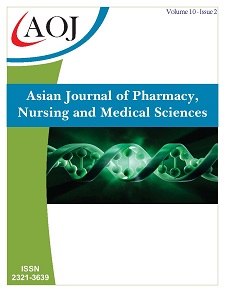Cost Comparison of Pressure Sores in the Last 4 Years and Evaluation of the Status of Patients Diagnosed with COVID: Acıbadem Healthcare Group Example
DOI:
https://doi.org/10.24203/ajpnms.v10i1.6830Keywords:
Pressure ulser, Nursing, Cost of Pressure ulserAbstract
It was designed as a retrospective study. Between January 2018 and June 2021, 590 patients who developed pressure ulcers from 16 hospitals affiliated with Acıbadem Healthcare Group (AHG) were identified and classified as Stage 1, Stage 2, Stage 3, Stage 4 and Unstageable pressure ulcer, suspected of deep tissue damage. The cost of treatment was calculated in each category and the total cost per patient for the company was determined.
There are two main ways to get data for analysis; 1- Sentinel Event System Reports (for determining the number of patients with pressure ulcers) and 2- Patient Services Pricing Department (for defining the cost of treatment). Costs and costing given by the pricing department with a bottom-up approach are calculated from the patient perspective.
Pressure sore cost calculation for COVID-19 patients covers the period from March 2020 to June 2021.
Data analysis: Two main ways were used to collect data for analysis; 1- Sentinel Event Notification System Reports (for determining the number of patients with pressure ulcers) and 2- Patient Services Pricing Department (for defining the cost of treatment).
Population: All patients who developed pressure ulcers in 16 hospitals affiliated to Acıbadem Healthcare Group since 2018
References
Agency for Healthcare Research Quality (2013). Measure Summary.Retrieved from: http://www.qualitymeasures.ahrq.gov/content.aspx?id=38513.
Saliha Koc1 , Neşe Bakoglu2 , Aslıhan Bardak3*Cost Analysis of Pressure Ulcers Cases in Acibadem Healthcare Group Asian Journal of Pharmacy, Nursing and Medical Sciences (ISSN: 2321 – 3639) Volume 02 – Issue 06, December 2014
Shahin ESM, Dassen T, Halfens RJG. Pressure ulcer prevalence in intensive care patients: a cross‐sectional study. J Eval Clin Pract. 2008;14(4):563–8. https://doi.org/10.1111/j.1365-2753.2007.00918.x
Phua J, Weng L, Ling L, Egi M, Lim C-M, Divatia JV, et al. Intensive care management of coronavirus disease 2019 (COVID-19): challenges and recommendations. Lancet Respir Med. 2020;8(5):506–17. https://doi.org/10.1016/S2213-2600(20)30161-2
Wounds International 2021 | Vol 12 Issue 3 | ©Wounds International 2021 | www.woundsinternational.com
Sorbello M, El-Boghdadly K, Di Giacinto I, et al; Società Italiana di Anestesia Analgesia Rianimazione e Terapia Intensiva (SIAARTI) Airway Research Group, and The European Airway Management Society. The Italian coronavirus disease 2019 outbreak: recommendations from clinical practice. Anaesthesia 2020;(March):1–9
Laveena Munshi 1, Lorenzo Del Sorbo 1, Neill K J Adhikari 2, Carol L Hodgson 3, Hannah Wunsch 4, Maureen O Meade 5, Elizabeth Uleryk 6, Jordi Mancebo 7, Antonio Pesenti 8, V Marco Ranieri 9, Eddy Fan 1,
‘’Prone Position for Acute Respiratory Distress Syndrome. A Systematic Review and Meta-Analysis.’’ 2017 Oct;14(Supplement_4):S280-S288. doi: 10.1513/AnnalsATS.201704-343OT.
Black JM, Cuddigan JE, Walko MA et al (2010) Medical device related pressure ulcers in hospitalized patients. Int Wound J 7:(5)358–365. https://doi.org/10.1111/j.1742-481X.2010.00699.x (accessed 26 October 2020)
Girard R, Baboi L, Ayzac L, Richard JC, Guérin C; Proseva trial group. The impact of patient positioning on pressure ulcers in patients with severe ARDS: results from a multicentre randomized controlled trial on prone positioning. Intensive Care Med 2014;40(3):397–403
Wang D, Hu B, Hu C, Zhu F, Liu X, Zhang J, et al. Clinical characteristics of 138 hospitalized patients with 2019 novel coronavirus–infected pneumonia in Wuhan, China. Jama. 2020;323(11):1061–9. https://doi.org/10.1001/jama.2020.1585
Guan W, Ni Z, Hu Y, Liang W, Ou C, He J, et al. Clinical characteristics of coronavirus disease 2019 in China. N Engl J Med. 2020;382(18):1708–20. https://doi.org/10.1056/NEJMoa2002032
Çinar F, Kula Şahin S, Eti Aslan F. ‘’Yoğun bakim ünitesi’nde basinç yarasinin önlenmeye yönelik türkiye’de yapilmiş çalişmalarin incelenmesi; sistematik derleme’’, (2018),: 7:1, 42 – 50.
Downloads
Published
Issue
Section
License
Copyright (c) 2022 Saliha Koç Aslan, Gülay Göçmen, İlknur Yurdakul

This work is licensed under a Creative Commons Attribution-NoDerivatives 4.0 International License.
- Papers must be submitted on the understanding that they have not been published elsewhere (except in the form of an abstract or as part of a published lecture, review, or thesis) and are not currently under consideration by another journal published by any other publisher.
- It is also the authors responsibility to ensure that the articles emanating from a particular source are submitted with the necessary approval.
- The authors warrant that the paper is original and that he/she is the author of the paper, except for material that is clearly identified as to its original source, with permission notices from the copyright owners where required.
- The authors ensure that all the references carefully and they are accurate in the text as well as in the list of references (and vice versa).
- Authors retain copyright and grant the journal right of first publication with the work simultaneously licensed under a Attribution-NonCommercial 4.0 International that allows others to share the work with an acknowledgement of the work's authorship and initial publication in this journal.
- Authors are able to enter into separate, additional contractual arrangements for the non-exclusive distribution of the journal's published version of the work (e.g., post it to an institutional repository or publish it in a book), with an acknowledgement of its initial publication in this journal.
- Authors are permitted and encouraged to post their work online (e.g., in institutional repositories or on their website) prior to and during the submission process, as it can lead to productive exchanges, as well as earlier and greater citation of published work (See The Effect of Open Access).
- The journal/publisher is not responsible for subsequent uses of the work. It is the author's responsibility to bring an infringement action if so desired by the author.


